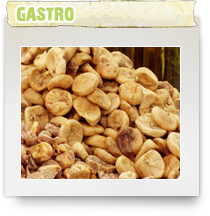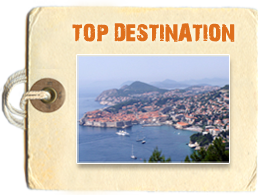 Croatian cuisine is very diverse and therefore known as a cuisine consisting ofmany regions. It goes back to Proto Slavic and ancient times. Differences in the selection of ingredients and ways of preparation are most obvious when we compare the continental part to the coastal regions. The continental cuisine, with its typical Proto Slavic roots is also influenced by the more famous cuisines of Hungary, Vienna, and Turkey. The cuisine on the coast was firs t influenced by the Greeks, Romans, and Illyrians, and later by the Mediterranean cuisines of Italy and France.
Croatian cuisine is very diverse and therefore known as a cuisine consisting ofmany regions. It goes back to Proto Slavic and ancient times. Differences in the selection of ingredients and ways of preparation are most obvious when we compare the continental part to the coastal regions. The continental cuisine, with its typical Proto Slavic roots is also influenced by the more famous cuisines of Hungary, Vienna, and Turkey. The cuisine on the coast was firs t influenced by the Greeks, Romans, and Illyrians, and later by the Mediterranean cuisines of Italy and France.
Istrian cuisine
Istrian traditional cuisine appeals to our eyes, nose and palate, and is a firstclass gastronomic experience when served with selected Istrian wines.
Today’sIstrian cuisine is the result of many changes that have occurred in Istria, as well as the influence of various nations who, for shorter or longer periods,stayed in Istria, usually as conquerors. However, the Istrian cuisine is mostlya result of the effort of common inhabitants of Istria who fed themselves with the food they grew, found in nature or caught.
Traditional Istrian dishes are: Istrian prsut (smoked ham), ravioli, fuzi s tartufima (typeof pasta with truffles), scrambled eggs with wild asparagus, chicken soup,vegetable stew with spring corn, cabbage prepared in a special way, pumpkindishes, lamb with potatoes prepared under a metal cover, wild game sauce, codfish prepared in a special way, octopus salad, ruccola salad with potatoes, fritule (type of doughnut), apple strudel.
Dalmatian cuisine
Dalmatian cuisine, due to its ingredients and preparation, meets all medical and nutritional recommendations for a healthy and well-balanced diet. Traditional Dalmatian ingredients are various types of fish, shells, crabs, octopus, squid, cuttle-fish, olives, olive oil, vegetables, wild and aromatic herbs, almonds, figs, grapes, honey, raisins and citrus fruits. Particularly delicious are Dalmatian "prsut" - smoked ham that is dried in the "bura" (north-eastern wind), best served with sheep-cheese, and "janjetina ispod peke" - lamb prepared in the traditional way under a metal cover. Furthermore, Dalmatian wines, both red andwhite, are a must with every meal and some of them are among the world's topten. The cuisine in Dalmatia and on its islands is in accordance to moderntrends in nutrition. Healthy methods of preparation (boiled or grilled), as wellas plenty of fish, olive oil, vegetables and wild herbs that can be found alongthe coast make Dalmatian cuisine extremely healthy. Although, even today, everyregion has its own unique methods of preparation, Dalmatian cuisine represents aunit whose characteristics have been discovered only recently, for example the cuisines of the islands of Hvar, Korcula, Brac (vitalac, a dish prepared with lamb innards and grilled), Vis (grilled pilchards, as in the times of theancient Greeks; pie with pilchards from Komiza and Vis, a dish similar to themodern pizza).
Wines
Croatia can boast of having a wide selection of excellent wines (there are anastounding 700 different types of wine with protected geographical origin), brandies, fruitjuices, beer and mineral waters. In the south, people drink “bevanda” (red wineof rich flavor mixed with water) with their meals, while in the northwest,people drink “gemist” (dry, aromatic wines mixed with mineral water) with theirmeals. Dalmatian wines, as well as olive oil and olives, have been cherishedsince ancient times. Names of wines such as Grk from the island of Korcula and Parc from the island of Hvar bear witness to this. Famous wines include Dingacand Posip from Peljesac Peninsula; Babic from Primosten; Vugava and Plancic fromthe island of Hvar… as well as Posip and Grk from t04-Jul-2012 5:48 PMa from Dubrovnik, and so on.
Furthermore, there is Prosecco (a sweet desert wine), very strong grape brandy, herb flavored brandies and liqueurs (Maraschino, Vlahov).
source: Generalturist





